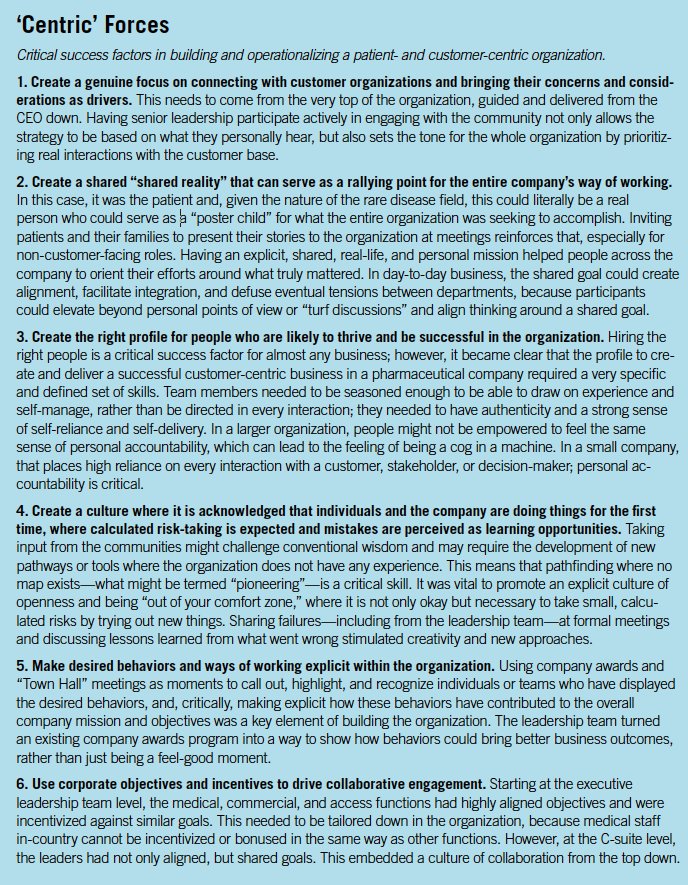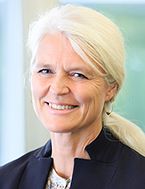Patient & Customer-Centric Commercialization
Pharmaceutical Executive
Outlining a real-world example in which building and operationalizing a patient- and customer-centric commercialization strategy drove a successful launch from a “standing start.”
Outlining a real-world example in which building and operationalizing a patient- and customer-centric commercialization strategy drove a successful launch from a “standing start”
Patient-centricity and customer-centricity are high on the agenda of many pharmaceutical companies. Most state that they are patient- and customer-centric or have an aspiration to be so. But what does that look like in reality, and how does one create, build, and lead a patient- and customer-centric approach from an operational perspective? And is it merely a branding or “feel-good” exercise, or can this approach drive deeper benefits, both from a business perspective and in terms of employee engagement?
Such an approach can actually drive both, which may be a critical differentiator when “time to launch” and return on investment is under increasing pressure, and at a time when engaging effectively with the workforce to bring best results with tightened resources is a defining success factor for leadership teams.
Doing the right thing, the right way
Many decision-makers are critical to the successful launch and commercialization of a new treatment. Regulatory authorities must approve a new drug; physicians have to believe in the utility of the product and understand where it fits in their therapeutic arsenal; payers or reimbursement authorities need to agree to fund it; and, ultimately, patients and their families have to believe that they will benefit from it.
This means there is a complex series of stakeholders and decision-makers-essentially customer communities-that needs to be engaged to deliver the successful launch and commercialization of a new drug. And when different effective treatment regimens are established, finding a place for a new drug can be a challenging and complex process, particularly in some rare disease areas, where communities can be close-knit.
In order to meet these challenges, the leadership team, in this case study, identified “Patient- & Customer-Centric Commercialization” as a way of operating. The objective was to create an organization that actively sought dialogue with each decision-maker or stakeholder to understand their needs, and to create collaborative approaches to respond to those needs; in other words, a unified cross-functional launch team-commercial, medical affairs, and access-supported by HQ functions, whose operating model was based on listening and responding, rather than “talking and telling” or selling.
Each function within the launch team consulted as early as possible with the decision-maker, or customer, at each stage of the process to bring their concerns or needs into the internal strategies and decision-making; the resulting plans and roll-out were built on the basis of addressing these concerns. This started with building a total understanding of the patient journey-the experience and the touchpoints that a person with a given condition experiences. This set of experiences and interactions served as a roadmap for the launch teams. By understanding this and then treating each decision-maker as a facilitator rather than a barrier, seeking to align the company’s approach to the decision-makers’ insights at each step in the development and availability process, the teams were able to create integrated and impactful outcomes. Indeed, all country launch plans were required to include a fully integrated commercial, medical, and access approach with an accompanying map of
Six 'Centric' Success Factors; click to enlarge

the respective “patient journey” for that country. This map included the stakeholder and support network, with actions for how to appropriately support and engage.
The result of this approach was a launch franchise getting to market in shorter timelines than the industry average in almost every European country, reaching almost €300 million in European revenues in just two years. The company went from being a relative unknown in a competitive field dominated by big pharma companies in 2012 to top rankings in the therapeutic area by 2017 and trusted as a brand. The company was also able to negotiate price increases for a product that was, for historical reasons, dramatically underpriced to the level of commercial unviability in some key markets. Rather than being forced to withdraw the product, the company was able to work with health authorities to secure more realistic prices that allowed it to continue to make the treatment available.
The approach also had a motivational effect on the internal company community, creating a workforce that felt genuinely engaged and empowered to deliver. Aligning alongside the patient journey to understand what customers at all stages of the process wanted and needed and creating a built-in approach that aligned with those needs were aspects that harnessed employee motivation. At a time when resources are stretched, inter-generational interactions between leaders and incoming talent is a key focus; the ability to engage across the organization is a core leadership skill. A cross-functional, cross-border focus on the patient was a key element in creating motivation and a sense of purpose.
The approach to building and operationalizing a patient- and customer-centric business took place against a backdrop where interactions with all stakeholders are under the spotlight and stakeholders themselves are alert to perceived undue influence. In many parts of the decision chain, interactions are strictly regulated-there are clear rules about when and how companies may communicate with regulatory authorities, and how company-physician or key opinion leader (KOL) interactions should happen. Other stakeholders, such as patient representatives, are guided by codes of conduct. Thus, what is appropriate outreach or interaction is in the hands of the company and its individuals. The waynotto do it may only be discovered after mistakes have been made and the repercussions felt by the organization and the business.
It was vital to orient all members of the company around the rapidly changing external environment and appropriate behaviors, taking into account not only the legislative framework, but also individual accountability. In a diverse business with many different conversations happening across geographies, business units, and functions, reliance on heavy rules can lead to inertia; individuals can become fearful of taking the initiative. In order to be compliant with the rules and, at the same time, facilitate a pioneering, integrated approach, personal awareness and accountability was a critical success factor to navigate grey areas and still “do the right thing” in terms of compliance. Raising employee self-awareness helped to ensure that the company was conducting its business appropriately, while still working collaboratively with decision-makers and communities and allowing internal decision-making to be guided by what the external customers needed.
Collaboration with payers and patient reps is essential
The patient- and customer-centric model extended across almost all aspects of the business, from designing the packaging to the medical teams’ interactions with physicians, as well as the engagement with academic, clinical, and regulatory bodies. The approach to two of the key communities-payers and patients-arguably gave the most significantly pioneering results in terms of building a successful commercial launch that respected the integrity of all the communities involved.
1. Collaborating with pricing authorities to accelerate positive pricing & reimbursement decisions
To address the many pricing hurdles in a launch preparation, we initiated a program of individual dialogue with the pricing and reimbursement authorities in each individual European country. We used the dialogue to understand where the payers saw the biggest challenges in agreeing to pay for the new treatments, and how these could be overcome. The HQ teams built this feedback into the pricing and reimbursement strategy and materials. This resulted in an approach to pricing, provision of specific evidence that the budget holders needed, and the development of further data, where needed, in order to move the conversations forward-all of which was based directly on payer input. We were able to reduce times to positive reimbursement decisions across the launch markets, and in some cases, almost one year faster than the industry average.
2. Collaborating with the patient community to create meaningful programs for the therapeutic area
In well-defined rare diseases, the patient communities are represented by not-for-profit associations in a tightly knit community that is well-organized and structured. Funds, for a large part, come from companies developing and manufacturing therapies for the condition in question. This can create potential tensions, because companies might express a desire to influence which activities and programs the associations undertake, while the associations might feel pressured to follow the companies’ suggestions.
To engage the patient community on a customer-centric basis, the launch teams invested in creating a real and very genuine dialogue with the community lead representatives. By diving deeper into what really mattered for the community, the organization discovered several areas where the patient representatives felt unable to initiate and develop programs that were of critical importance to them. That was because such programs did not give rise to “traditional” areas of publicity and, therefore, were not of sufficient interest for companies to fund. By identifying these areas and putting together programs of support that were driven by the patient needs rather than the company’s ability to participate or “brand” the offering, the team was able to forge a more meaningful approach to positioning the new therapies in the context of existing established treatment options.
Indeed, the approach to the payers was born of a request from the patient leadership, which expressed that one of its biggest concerns was that the new therapies would only reach “the privileged few.” Its guidance led to the payer outreach program mentioned earlier and an approach that was built on “pricing for access”-to secure that the new, first-in-class therapeutic options could reach as broad a community as possible.
Competitive boost
In our case, it could be argued that necessity drove a need to develop and deliver a patient- and customer-centric approach to commercialization. The company was relatively small, with no dedicated medical or sales force in place for the therapeutic area. It was a relatively unknown organization in the therapy area, seeking to enter a market dominated by large, well-established players. The launch was critical to the future of the company. Building on the drugmaker’s rare disease legacy by identifying a genuine and sustainable patient- and customer-centric operating model was a way to turn its small scale and newness in the field to its advantage.
Adopting this model meant that the organization was able to successfully enter and launch in an established competitive landscape and to win business from a standing start and in a short time horizon. It also created an engaged and motivated workforce “with a heart.” Most importantly, the approach helped facilitate earlier patient access to a more advanced and beneficial treatment.



Wills Hughes-Wilson is Head of Patient Access & Commercial Planning at Mereo Biopharma. Alan Raffensperger is CEO at Inceptua. Birgitte Volck is the former Head of R&D for GSK Rare Diseases, and is a non-executive director on several biotech boards.

Addressing Disparities in Psoriasis Trials: Takeda's Strategies for Inclusivity in Clinical Research
April 14th 2025LaShell Robinson, Head of Global Feasibility and Trial Equity at Takeda, speaks about the company's strategies to engage patients in underrepresented populations in its phase III psoriasis trials.